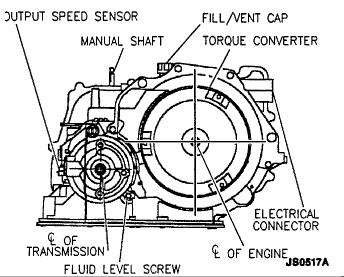Start engine and drive vehicle until the transaxle reaches operating temperature of 82-130 °C (180-200 °F) . This temperature is reached after about 24 km (15 miles) of driving.
NOTICE: Temperature will greatly affect transmission oil level. If the vehicle is not at normal operating temperature and the proper checking procedures are not followed, the result could be a false reading of the oil level indicator and an incorrect adjustment of the oil level.
Inaccurate oil level readings will result if the oil is checked immediately after the vehicle has been operated under certain conditions:
In high ambient temperature above 32 °C (90 °F).
At sustained high speeds.
In heavy city traffic during hot weather.
As a towing vehicle.
In commercial service (taxi or police use).
If the vehicle has been operated under these conditions, shut the engine off and allow the vehicle to cool for thirty minutes. Then restart the vehicle and continue from step two.
The fluid level screw is intended to be used for diagnosing a transaxle fluid leak or resetting the transaxle fluid level after service that involves a loss of fluid.
Inspect
The fluid level should be checked when the transaxle is near Room temperature or at 40 °C (104 °F) .
CAUTION: Removal of the fluid level screw when the transaxle fluid is hot may cause injury. Use care to avoid contact of transaxle fluid to exhaust pipe.
The engine must be running when the transaxle fluid level screw is removed, or excessive fluid loss will occur. Since the actual fluid level is unknown, stand clear when removing the fluid level screw. Have a container ready to capture any lost fluid.
WARNING: Do not turn the engine off with the fluid level screw removed as you can be injured by hot transaxle fluid being expelled out of the fluid check hole.
Let vehicle idle for three to five minutes with accessories off.
Apply brake
Move shift lever through all gear ranges, pausing three seconds in each range.
Place shift lever in Park. Important: Vehicle must be kept level on the hoist.
Raise vehicle on hoist.
Place oil container under fluid level screw.
Remove the fluid with the engine running at idle.
Fluid level should be at the bottom of the fluid check hole. Because the transaxle operates correctly over a range of fluid levels, fluid may or may not drain out of the fluid check hole when the fluid level screw is removed. If fluid drains through the fluid check hole, this transaxle may have been overfilled. When fluid stops draining, the fluid level is correct and the fluid level screw may be installed. If fluid does not drain through the fluid check hole, the transaxle fluid level may be low. Proceed to ADDING TRANSAXLE FLUID.
Install fluid level screw. Tighten 12 N.m (106 lb in)
Lower vehicle.
Shut off engine. Adding Transaxle Fluid: With the engine running, add fluid at the vent cap location in half liter (1 pint) increments until fluid drains through the fluid check hole. Allow the fluid to finish draining through the fluid check hole.
Install fluid level screw. Tighten 12 N.m (106 lb in)

follow this info.
SPONSORED LINKS
Saturday, April 4th, 2009 AT 3:19 PM



